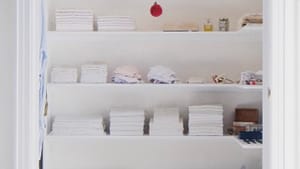Stay in the Loop
BSR publishes on a weekly schedule, with an email newsletter every Wednesday and Thursday morning. There’s no paywall, and subscribing is always free.
What’s in her closet?
The National Museum of American Jewish History presents ‘Sara Berman’s Closet’

You can learn a lot about a person by looking through her closet. Next time you’re near the National Museum of American Jewish History (NMAJH) at 5th and Market, take a peek into Sara Berman’s superbly organized closet, which looks just as she left it 14 years ago. You don’t have to leave the sidewalk.
After inspecting the meticulous shelves of impeccably pressed and folded clothing outside the NMAJH, go inside. Sara Berman’s Closet: A Small and Monumental Story strikes a chord with almost everyone, encompassing resettlement, persistence, humor, difficulty, misadventures, interesting relatives, self-determination, and deciding what to wear. Berman’s story is at once singular and universal.
What’s in your closet?
After Berman passed away in 2004, her daughter and grandson, Maira and Alex Kalman, preserved the contents and arrangement of the closet in Berman’s Greenwich Village studio. They catalogued underwear, T-shirts, nightgowns, sweaters, linens, pocket books, shoes, and accessories, mostly in shades of white, all tidily arranged.
Maira, an author and artist, and Alex, a designer and curator, considered the collection of items a work of cultural anthropology and envisioned creating a small exhibit. A decade later, Sara Berman’s Closet opened at Alex Kalman’s Mmuseumm in Manhattan. Surprising developments followed.
From the small Mmuseumm, the recreated closet was invited to New York’s Metropolitan Museum of Art, and to the Skirball Cultural Center in Los Angeles. The Kalmans collaborated on a wry illustrated memoir about Berman’s life and times, published in 2018: Sara Berman’s Closet: A Small and Monumental Story.
In Philadelphia the project has become a three-dimensional version of the book. NMAJH’s Josh Perelman worked with the Kalmans to fill a gallery with photographs, artifacts, Maira Kalman’s illustrations, and captions written in her cheerfully eccentric hand. What’s next? Think Sara Berman’s Closet: A Small and Monumental Opera. The Kalmans say it’s possible.
All this indicates that Berman’s relatives aren’t the only ones who see something special in her. Speaking last fall at New York’s Strand Bookstore, Maira Kalman said, “The closet was … a way to create order out of chaos, a way to create a life of beauty and meaning, and that is no small achievement.”
Before Marie Kondo
Berman was born in Belarus and as a child moved to Palestine (later the state of Israel). She married and gave birth to two daughters, and the family emigrated to New York. When her daughters were in college, Berman and her husband Pesach returned to Tel Aviv, where she stayed until 1980. Then, at age 60, she packed a single suitcase and left what had been a difficult marriage. Returning to New York, she found an apartment and began life on her own terms.

According to the memoir, “She edited out useless distractions. She cherished the small moments, which everyone knows are the sweetest.” Berman cooked blintzes, read autobiographies, watched movies starring Fred Astaire and Danny Kaye, and visited the Met. “One Friday, in a burst of personal expression, she decided to wear only white.” Long before Marie Kondo, Sara Berman knew about editing possessions and finding joy.
Not a shrine
“Sara’s story connects very deeply to the core of this museum,” says Perelman, NMAJH director of exhibitions and interpretation. “It dovetails with the story of American Jewish history … and the values enshrined in Independence Hall,” a block away.
Maira Kalman explains that the aim was not to create a monument to her mother: “We wanted to make it clear that this … was about humanism and history and art and fashion and life and sorrow and humor.”
That humor in particular filters through the presentation, as does the companionable banter of the Kalmans, who will be on hand periodically through the run. On July 4, they plan to distribute Berman’s favorite lemon ice pops to the public.
A fairy tale, mostly true
Walking through the gallery, Alex Kalman said that the book and exhibit are a fairy tale of his grandmother’s life—mostly factual, but they include the fanciful lore families preserve and pass on. The exhibit documents both.
For instance, there’s a corked bottle of water from the River Sluch, the waterway in the village where Berman was born, into which she fell. She was saved, the story goes, by her grandfather, who threw his six-foot-long beard into the rushing current.
There is a freshly built shack like those in Lenin, her childhood village. It’s thickly carpeted with downy goose feathers, because, well, there were geese. For the sake of clarification, there’s a banner of Communist leader Vladimir Lenin, for whom the village was not named (it was for Princess Lenina). Nearby stands the brown suitcase, edged in green, that Berman carried on her 1980 return to America. Also on display is a kindergarten-sized chair from her apartment; Maira Kalman said Berman liked it because it fit her.
The exhibit is so whimsical and charming that visitors should take care not to miss its clear-eyed point: Whatever circumstances life hands us, we choose how to respond. We determine how to use the time we’re given. We decide what deserves space in our closet.
What, When, Where
Sara Berman’s Closet: A Small and Monumental Story. Through September 2, 2019, at the National Museum of American Jewish History, 101 South Independence Mall East, Philadelphia. (215) 923-3811 or nmajh.org.
All public areas of NMAJH are wheelchair-accessible, and a limited number of wheelchairs are available to the public on a first-come, first-served basis. Accommodations throughout the museum include assistive listening devices, captioned films, Braille signage, and sensory backpacks. To address a specific need, contact the museum.
Sign up for our newsletter
All of the week's new articles, all in one place. Sign up for the free weekly BSR newsletters, and don't miss a conversation.
